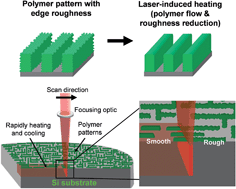Controlled roughness reduction of patterned resist polymers using laser-induced sub-millisecond heating†
Abstract
High resolution polymer resist systems are critical for nanometer-scale photolithographic patterning. Substantial research has explored modifications in resist formulations and pattern development protocols to control critical dimensions (CD) and line width roughness (LWR), and post-development treatment of polymer patterns has also received active attention. In this work, we use a laser-induced heating technique (λ = 10.6 μm) to anneal (hardbake) fully developed polymer patterns at peak temperatures between 175–450 °C for 500 μs. Polymer flow at temperatures far above the glass transition (∼100 °C) enables surface energy minimization to reduce pattern roughness. Results from this laser hardbake process are compared to conventional techniques using a vacuum-chuck hot-plate at 90–150 °C for 30 s. At low temperatures, surface roughness can be reduced only with unacceptable loss of the sidewall angle and trench profiles. In contrast, reductions in LWR (from 6.4 nm to 2.6 nm) and surface roughness of 35% are achieved with less than 1 nm change in CD for a common acrylate-based polymer under the laser hardbake at elevated temperatures. Minimal changes in the sidewall angle and trench profiles are observed due to nano-scale flow over the sub-millisecond time frames. This novel sub-millisecond heating technique provides a means to reduce roughness by surface energy minimization in high resolution polymer patterns with minimal resolution loss, potentially complementing other advances in high performance photolithography.


 Please wait while we load your content...
Please wait while we load your content...